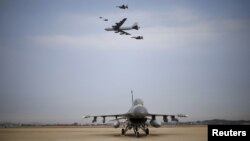While China remains non-committal on how to respond to North Korea’s fourth nuclear test, the United States and South Korea are exercising their limited options to increase deterrence and punitive measures against the Kim Jong Un government.
Following Washington’s deployment of a B-52 bomber capable of carrying nuclear weapons to the Korean peninsula over the weekend, the two militaries are considering additional demonstrations of force and increasing their joint military presence in the region.
"The United States and South Korea are continuously and closely having discussions on additional deployment of strategic assets on the Korean peninsula," said Kim Min-seok, South Korea’s Defense Ministry spokesman on Monday.
The comments are adding to media speculation that Washington could move the USS Ronald Reagan, its nuclear-powered aircraft carrier stationed in Japan, into Korean waters and also bring in B-2 stealth bombers and F-22 stealth fighter jets.
U.S. forces in South Korea were also put on their highest level of alert on Monday.
The U.S. military has nearly 30,000 troops in South Korea, but can also quickly deploy additional conventional forces and armaments including nuclear weapons from regional bases in Japan and Guam.
South Korea and Japan also used their shared military hotline for the first time in the aftermath of North Korea's nuclear test. The two military allies of the United States have been working to overcome strained bilateral relations over Japan’s conduct during World War II to better deal with the increasing nuclear threat they both face from North Korea.
No answer from China
In contrast to its outreach to Washington and Tokyo, Seoul’s Defense Ministry has so far been unable to contact its counterpart in Beijing.
“At this point, China’s Defense Ministry is not speaking on the phone with any countries. So we have requested for a call and waiting for a response,” said Kim Min-seok.
North Korea’s recent nuclear test has further strained its relationship with China, its key provider of economic aid and trade. Beijing criticized Pyongyang for violating again a U.N. ban on its nuclear program, but is also reluctant to support strong sanctions or military measures that escalate the risk of conflict and instability on its border.
North Korea analyst Shin In-kyun with the Korea Defense Network in Seoul said China is also conflicted about the increased U.S.-South Korean military moves in the region.
“If China protests against our self-defensive military responses, the relation between China and South Korea will be frozen. So I think it is difficult for China to show such response against us,” said Shin.
South Korean measures
South Korea’s Unification Ministry also took measures Monday to further limit the number of its citizens access the jointly run Kaesong industrial complex where approximately 120 South Korean firms employ over 53,000 North Korean workers.
"The move is aimed at securing the safety of South Koreans as the North is expected to react to Seoul's resumption of anti-North Korean loudspeaker broadcasts," said Unification Ministry Spokesman Jeong Joon-hee.
A business association representing South Korean companies in the Kaesong complex is urging the Seoul government not to shut down their operation.
Inter-Korea border tensions remain high as South Korea continues to run loudspeaker broadcasts inside the demilitarized zone (DMZ) that criticize North Korean leader Kim Jong Un. Last year the two sides exchanged artillery fire because of the loudspeakers before coming to an agreement to end further provocations; an agreement that Seoul says Pyongyang violated with its recent nuclear test.
North Korea has reportedly set up some loudspeaker stations of its own in the border area to drown out the South’s broadcasts.
South Korea’s Blue House announced Monday that President Park Geun-hye will make a public statement Wednesday and is expected to announce new punitive measures against North Korea.
North Korean Leader Kim Jong Un reiterated Monday his claim that last week’s test was of a miniaturized hydrogen bomb. This claim has been largely dismissed by experts who argue the yield was too low for a full-fledged thermonuclear device.
North Korea state television KCNA broadcast a photo of the North Korean leader with hundreds of scientists, workers and officials who participated in the latest test. KCNA said Kim congratulated the group for “succeeding in the first H-bomb test... and bringing about a great, historic event.”
Youmi Kim in Seoul contributed to this report.





